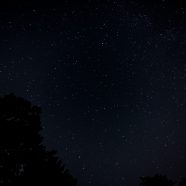The Big Dipper
Can you spot the Big Dipper just above the horizon between the trees? It can be hard to believe in the midsummer heat but birds are already migrating south for the winter both during the day (various swallows to Eastern Kingbirds to Blue-gray Gnatcatchers) and the night (Red-eyed Vireos to Indigo Buntings to Black-billed Cuckoos). Those nocturnal species use various methods to help them move around our planet – some may use a coastline, others the Earth’s magnetic field, and like people, certain birds gaze at the stars. Various species take in the night sky as a map, just as we...
Read MoreMilky Way
It is tough to find the stars in very populated areas such as coastal Connecticut with light pollution drowning everything out, including the Milky Way. Still, you can find a hint of it in this recent photo on a moonless night. At this time of year it can be more beautiful to be outside at night than during some hot days – be sure you get outdoors whenever you can! Keep an eye out for bats, moths, amphibians, mammals…life is going 24 hours a day.
Read MoreJupiter
Last night I put on my porch light and black light to see if any moths were in the air. They were not, yet – some have been already, though the conditions that night were not great for them and the temperature lately was not helpful. A chilly north wind kept migrant birds to a minimum, and I only heard a couple of call notes going over. I saw Jupiter shining brightly in the clearing sky. While Connecticut’s light pollution and my inexperience of shooting the night sky make it a little less pretty and a little more difficult (not to mention the moon since I hadn’t planned...
Read MoreCosta Rica Night Sky
Spending long nights in the rainforest hunting rare frogs has its perks…apart from spending long nights in the rainforest hunting frogs, that is… Twan Leenders RTPI President
Read MoreStarry Sky
It can be very difficult to see many of the stars or much of the night sky in many parts of Connecticut with far too much light pollution surrounding us, but I liked this view from last night. Orion can be seen well to the lower left of center. Birds use the North Star, or Polaris at the moment, during migratory flights as it is in a fixed position. Thankfully it can be seen regardless for the millions upon millions of birds that will be moving up our coast soon. Scott Kruitbosch Conservation & Outreach Coordinator
Read More








